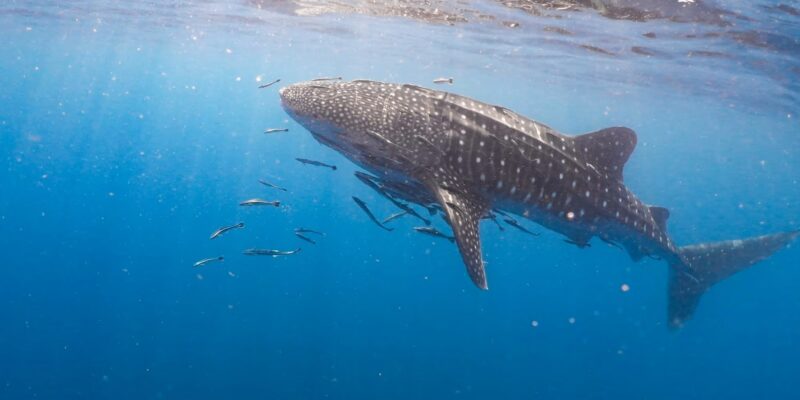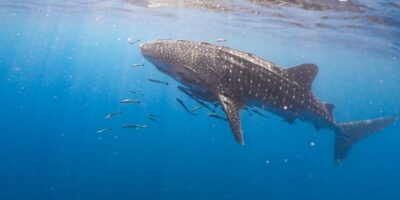Whale sharks are the largest fish on Earth and are highly threatened. A new study in the Bird’s Head Seascape off West Papua shows that 62% of the animals recorded there carry injuries – mostly caused by humans. Collisions with bagans (traditional lift-net platforms) and boats are particularly common, while the growing whale shark tourism brings additional risks. The good news: with simple adjustments to fishing gear and boat equipment, much harm could be prevented.
What the researchers found
Between 2010 and 2023, an international team documented whale sharks in Cenderawasih Bay, Kaimana (including Triton Bay), Raja Ampat, and Fakfak – a network of 26 marine protected areas. Using photo ID (unique spot patterns), 268 individuals were identified; 98% of sightings were in Cenderawasih Bay and Kaimana. More than half (52.6%) were re-sighted, with one young male recorded 34 times in three years. Around 90% of the animals were male, mostly juvenile whale sharks measuring four to five meters in length.
Of 206 documented animals with injuries or scars, 80.6% could be attributed to humans; 58.3% also showed signs of natural causes (multiple attributions possible). Severe injuries such as deep cuts, amputations, or blunt trauma caused by human interaction occurred in 17.7% of cases. More common were non-life-threatening abrasions – for example from rubbing against net edges, outriggers, or ship hulls when whale sharks suck up baitfish at bagans.
“Scars and injuries are mostly due to collisions with bagans and tour boats,” says study leader Dr. Edy Setyawan (Elasmobranch Institute Indonesia). “Natural causes play a much smaller role.”
Why so many young males – and where are the females?
Sightings were concentrated almost exclusively near bagans, where whale sharks feed on baitfish such as anchovies, herrings, or sprats – either gliding horizontally or in a vertical “head-up” position. According to satellite data, adult animals, especially females, are more often found over deep-sea structures such as canyons and seamounts and use the open ocean, while juvenile males prefer coastal, plankton-rich areas.
“Adult whale sharks – especially females – often use the deep sea and follow other prey such as krill and schooling fish,” explains co-author Mochamad Iqbal Herwata Putra (Konservasi Indonesia).
Simple solutions with big impact
Since most encounters occur at bagans and tourism is growing, the researchers expect more injuries without countermeasures. They propose small, immediately applicable interventions: removing sharp edges on outriggers and net frames, modifying nets and platforms to reduce risks, and establishing clear rules for tour boats in protected areas. This would significantly reduce scarring – while also securing the whale shark as a long-term resource for communities and authorities.
“With slight modifications to bagans – such as removing sharp edges – we can significantly reduce the rate of scarring,” says Dr. Mark Erdmann (Re:wild).
Since whale sharks reach sexual maturity late (up to 30 years), populations recover only slowly. Preventive measures against avoidable injuries are therefore all the more important – along with tourism that protects the “gentle giants” instead of endangering them.





